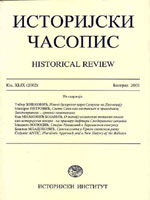Развој живинарства у Краљевини Србији
Development of Poultry Farming in the Kingdom Of Serbia
Author(s): Gordana Garić PetrovićSubject(s): History, Economic history
Published by: Istorijski institut, Beograd
Keywords: poultry farming; Kingdom of Serbia; agriculture; Serbian Agricultural Society; agricultural exhibitions
Summary/Abstract: Poultry farming was widespread in all parts of the Kingdom of Serbia. Sudden development of this branch of agriculture began in the late 19th and early 20th century when the demand for eggs and poultry meat increased in domestic and foreign markets. In that period, the Ministry of National Economy introduced new breeds of all sorts of poultry into state agricultural institutes and schools, with the aim to expand their farming. Breeding poultry was imported mainly from Germany. The imported chickens included the breeds of Brahma, Transylvanian, Langshan, Mechelen, Minorca, Orpington, Plymouth Rock, Italian, Houdan, Guinea fowl; geese: Pomeranian, Italian and Emden; and ducks: domestic, Pekin and Rouen. Of foreign breeds, Plymouth Rock and Orpington proved to be the best for our climate, rural method off arming and domestic needs. The first results of these efforts were evident at national exhibitions of poultry under the auspices of the Serbian Agricultural Society, held as of 1905. Prominent in this field were also private entrepreneurs such as Petar Trivunac, the owner of the poultry park „Jelenac” in Aleksinac, as well as female entrepreneurs such as Katinka V. Jovanović, the owner of the poultry farm „Dedinje”. In addition to the Serbian Agricultural Society, the cooperative movement in the Kingdom of Serbia also worked on improving poultry farming. At its XII congress, a decision was made to establish the Poultry Cooperative. What also greatly contributed to the promotion of poultry farming in Serbia were several slaughterhouses, opened in the late 19th and early 20th century. By purchasing poultry and eggs for foreign markets, they stimulated the development of poultry farming, particularly in Pomoravlje, near the railway, where the largest facilities were located. Velika Plana, with its two slaughterhouses – of K. Šeus and V. Šumaher, was one of the centres of the oldest food industry in Serbia. Klefiš’s slaughtering enterprise from Jagodina, founded in 1901, also exported poultry and eggs. These slaughterhouses, as well as the entire Serbian economy, faced great challenges at the time of the Customs War, when entire exports shifted from Austria-Hungary to the markets of France, Italy, as well as Germany, Switzerland and Spain. In the early 20th century, several areas boasted somewhat more progressive poultry farming practices. Belgrade with its environs featured most prominently, with Aleksinac following suit. Other poultry farming centres were Kragujevac, Šabac and Pirot. In terms of the absolute number of all sorts of poultry, the Požarevac district was in the forefront – in 1910, total 767,723 heads of different types of poultry were recorded. It was followed by Kragujevac, Morava and Podrinje districts.
Journal: Историјски часопис
- Issue Year: 2016
- Issue No: 65
- Page Range: 277-305
- Page Count: 29
- Language: Serbian

